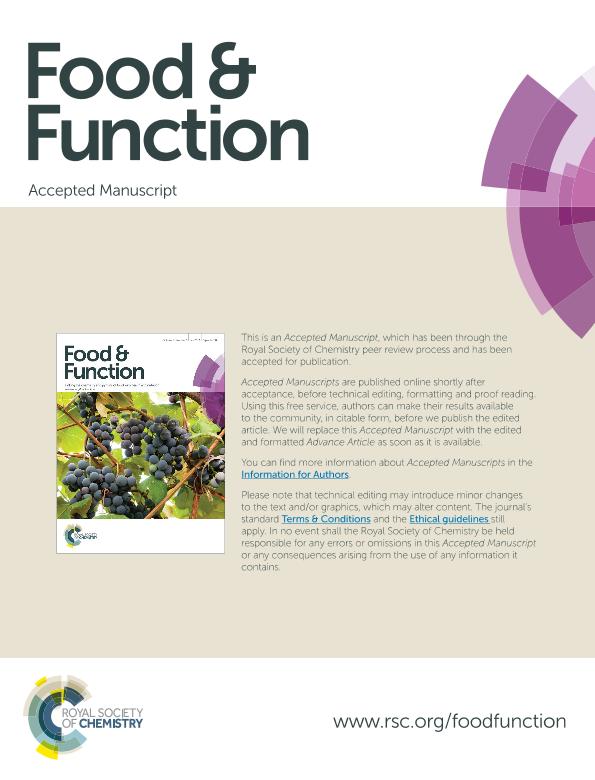Mostrar el registro sencillo del ítem
dc.contributor.author
López Froilán, R.
dc.contributor.author
Ramírez Moreno, E.
dc.contributor.author
Podio, Natalia Soledad

dc.contributor.author
Pérez Rodríguez, M.L.
dc.contributor.author
Cámara, M.
dc.contributor.author
Baroni, María Verónica

dc.contributor.author
Wunderlin, Daniel Alberto

dc.contributor.author
Sánchez Mata, M.C.
dc.date.available
2018-06-26T14:11:04Z
dc.date.issued
2016-06
dc.identifier.citation
López Froilán, R.; Ramírez Moreno, E.; Podio, Natalia Soledad; Pérez Rodríguez, M.L.; Cámara, M.; et al.; In vitro assessment of potential intestinal absorption of some phenolic families and carboxylic acids from commercial instant coffee samples; Royal Society of Chemistry; Food and Function; 7; 6; 6-2016; 2706-2711
dc.identifier.issn
2042-6496
dc.identifier.uri
http://hdl.handle.net/11336/50054
dc.description.abstract
Coffee is one of the most consumed beverages in the world, being a source of bioactive compounds as well as flavors. Hydroxycinnamic acids, flavonols, and carboxylic acids have been studied in the samples of instant coffee commercialized in Spain. The studies about contents of food components should be complemented with either in vitro or in vivo bioaccessibility studies to know the amount of food components effectively available for functions in the human body. In this sense, a widely used in vitro model has been applied to assess the potential intestinal absorption of phenolic compounds and organic acids. The contents of hydroxycinnamic acids and flavonols were higher in instant regular coffee samples than in the decaffeinated ones. Bioaccessible phenolic compounds in most analyzed samples account for 20-25% of hydroxycinnamic acids and 17-26% of flavonols. This could mean that a great part of them can remain in the gut, acting as potential in situ antioxidants. Quinic, acetic, pyroglutamic, citric and fumaric acids were identified in commercial instant coffee samples. Succinic acid was found in the coffee blend containing chicory. All carboxylic acids showed a very high bioaccessibility. Particularly, acetic acid and quinic acid were found in higher contents in the samples treated with the in vitro simulation of gastrointestinal processes, compared to the original ones, which can be explained by their cleavage from chlorogenic acid during digestion. This is considered as a positive effect, since quinic acid is considered as an antioxidant inducer.
dc.format
application/pdf
dc.language.iso
eng
dc.publisher
Royal Society of Chemistry
dc.rights
info:eu-repo/semantics/openAccess
dc.rights.uri
https://creativecommons.org/licenses/by-nc-sa/2.5/ar/
dc.subject
Cafe
dc.subject
Polifenoles
dc.subject
Nutricion
dc.subject
Antioxidantes
dc.subject.classification
Otras Ciencias Químicas

dc.subject.classification
Ciencias Químicas

dc.subject.classification
CIENCIAS NATURALES Y EXACTAS

dc.title
In vitro assessment of potential intestinal absorption of some phenolic families and carboxylic acids from commercial instant coffee samples
dc.type
info:eu-repo/semantics/article
dc.type
info:ar-repo/semantics/artículo
dc.type
info:eu-repo/semantics/publishedVersion
dc.date.updated
2018-06-13T14:17:22Z
dc.identifier.eissn
2042-650X
dc.journal.volume
7
dc.journal.number
6
dc.journal.pagination
2706-2711
dc.journal.pais
Reino Unido

dc.description.fil
Fil: López Froilán, R.. Universidad Complutense de Madrid; España
dc.description.fil
Fil: Ramírez Moreno, E.. Universidad Autónoma del Estado de Hidalgo. Instituto de Ciencias de la Salud; México
dc.description.fil
Fil: Podio, Natalia Soledad. Consejo Nacional de Investigaciones Científicas y Técnicas. Centro Científico Tecnológico Conicet - Córdoba. Instituto de Ciencia y Tecnología de Alimentos Córdoba. Universidad Nacional de Córdoba. Facultad de Ciencias Químicas. Instituto de Ciencia y Tecnología de Alimentos Córdoba; Argentina
dc.description.fil
Fil: Pérez Rodríguez, M.L.. Universidad Complutense de Madrid; España
dc.description.fil
Fil: Cámara, M.. Universidad Complutense de Madrid; España
dc.description.fil
Fil: Baroni, María Verónica. Consejo Nacional de Investigaciones Científicas y Técnicas. Centro Científico Tecnológico Conicet - Córdoba. Instituto de Ciencia y Tecnología de Alimentos Córdoba. Universidad Nacional de Córdoba. Facultad de Ciencias Químicas. Instituto de Ciencia y Tecnología de Alimentos Córdoba; Argentina
dc.description.fil
Fil: Wunderlin, Daniel Alberto. Consejo Nacional de Investigaciones Científicas y Técnicas. Centro Científico Tecnológico Conicet - Córdoba. Instituto de Ciencia y Tecnología de Alimentos Córdoba. Universidad Nacional de Córdoba. Facultad de Ciencias Químicas. Instituto de Ciencia y Tecnología de Alimentos Córdoba; Argentina
dc.description.fil
Fil: Sánchez Mata, M.C.. Universidad Complutense de Madrid; España
dc.journal.title
Food and Function
dc.relation.alternativeid
info:eu-repo/semantics/altIdentifier/doi/http://dx.doi.org/10.1039/C6FO00315J
dc.relation.alternativeid
info:eu-repo/semantics/altIdentifier/url/https://rsc.li/2lxrlee
Archivos asociados
